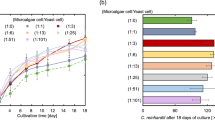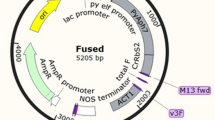Abstract
Two unicellular cyanobacteria Synechocystis sp. PCC 6803 and Synechococcus elongatus PCC 7942 showed contrasting responses to chromate stress with EC50 of 12 ± 2 and 150 ± 15 μM potassium dichromate respectively. There was no depletion of chromate in growth medium in both the cases. Using labeled chromate, very low accumulation (<1 nmol/108 cells) was observed in Synechocystis after incubation for 24 h in light. No accumulation of chromate could be observed in Synechococcus under these conditions. Chromate oxyanion is known to enter the cells using sulfate uptake channels. Therefore, inhibition of sulfate uptake caused by chromate was monitored using 35S labeled sulfate. IC50 values of chromate for 35sulfate uptake were higher in Synechococcus as compared to Synechocystis. The results suggested that the sulfate transporters in Synechococcus have lower affinity to chromate than those from Synechocystis possibly due to differences in affinity of sulfate receptors for chromate. Bioinformatic analyses revealed presence of sulfate and chromate transporters with considerable similarity; however, minor differences in these may play a role in their differential response to chromate. In both cases the IC50 values decreased when sulfate concentration was reduced in the medium indicating competitive inhibition of sulfate uptake by chromate. Interestingly, Synechococcus showed stimulation of growth at concentrations of chromate less than 100 μM, which affected its cell size without disturbing the ultrastructure and thylakoid organization. In Synechocystis, growth with 12 μM potassium dichromate damaged the ultrastructure and thylakoid organization with slight elongation of the cells. The results suggested that Synechococcus possesses efficient strategies to prevent entry and to remove chromate from the cell as compared to Synechocystis. This is the first time a differential response of Synechococcus 7942 and Synechocystis 6803 to chromate is reported. The contrasting characteristics observed in the two cyanobacteria will be useful in understanding the basis of resistance or susceptibility to chromate.




Similar content being viewed by others
Abbreviations
- EC50 of chromate:
-
Concentration of potassium dichromate at which number of cells ml−1 was 50 % as compared to control
- IC50 of chromate:
-
Concentration of chromate required for 50 % reduction in uptake of sulfate as compared to control
- OD:
-
Optical density
References
Aguilar-Barajas E, Dı′az-Pe′rez C, Ramirez-Diaz M, Riveros-Rosas H, Cervantes C (2011) Bacterial transport of sulfate, molybdate, and related oxyanions. Biometals 24:687–707
Aguilar-Barajas E, Jeronimo-Rodriguez P, Ramirez-Diaz MI, Rensing C, Cervantes C (2012) The ChrA homologue from a sulfur-regulated gene cluster in cyanobacterial plasmid pANL confers chromate resistance. World J Microbiol Biotechnol 28:865–869
Alvarez AH, Moreno-Sanchez R, Cervantes C (1999) Chromate efflux by means of the ChrA chromate resistance protein from Pseudomonas aeruginosa. J Bacteriol 181:7398–7400
Anjana K, Kaushik A, Kiran B, Nisha R (2007) Biosorption of Cr(VI) by immobilized biomass of two indigenous strains of cyanobacteria isolated from metal contaminated soil. J Hazard Mater 148:383–386
Cervantes C, Compos-Garcia J, Devars S, Gutie’rrez-Corona F, Loza-Tavera H, Torres-Guzman JC, Moreno-Sanchez R (2001) Interactions of chromium with microorganisms and plants. FEMS Microbiol Rev 25:335–347
Cheung KH, Gu JD (2007) Mechanism of hexavalent chromium detoxification by microorganisms and bioremediation application potential: a review. Int Biodeter Biodegrad 59:8–15
Fulda S, Huckauf J, Schoor A, Hagemann M (1999) Analysis of stress responses in the cyanobacterial strains Synechococcus sp. PCC 7942, Synechocystis sp. PCC 6803, and Synechococcus sp. PCC 7418: osmolyte accumulation and stress protein synthesis. J Plant Physiol 154:240–249
Garnham GW, Green M (1995) Chromate(VI) uptake and interactions with cyanobacteria. J Ind Microbiol 14:247–251
Italiano F, Rinalducci S, Agostiano A, Zolla L, Leo DF, Ceci LR, Trotta M (2012) Changes in morphology, cell wall composition and soluble proteome in Rhodobacter sphaeroides cells exposed to chromate. Biometals. doi:10.1007/s10534-012-9561-7
Khattar JIS, Sarma TA, Sharma A (2004) Effect of Cr6+ stress on photosynthetic pigments and certain physiological processes in the cyanobacterium Anacystis nidulans and its chromium resistant strain. J Microbiol Biotechnol 14:1211–1216
Kiran B, Kaushik A, Kaushik CP (2007) Response surface methodological approach for optimizing removal of Cr(VI) from aqueous solution using immobilized cyanobacterium. Chem Eng J 126:147–153
Kiran B, Rani N, Kaushik A (2008) Chromium(VI) tolerance in two halotolerant strains of Nostoc. J Environ Biol 29:155–158
Nies DH, Koch S, Wachi S, Pietzsch N, Saier MH (1998) CHR, a novel family of prokaryotic proton motive force-driven transporters probably containing chromate/sulfate antiporters. J Bacteriol 180:5799–5802
Ozturk S, Aslim B, Suludere Z (2009) Evaluation of chromium(VI) removal behavior by two isolates of Synechocystis sp. in terms of exopolysaccharide (EPS) production and monomer composition. Bioresource Technol 100:5588–5593
Rami’rez-Diaz MI, Diaz-Perez C, Vargas E, Riveros-Rosa H, Compos-Garcia J, Cervantes C (2008) Mechanisms of bacterial resistance to chromium compounds. Biometals 21:321–332
Reynolds ES (1963) The use of lead citrate at high pH as electron-opaque stain for electron microscopy. J Cell Biol 17:208–212
Riedel GF (1985) The relationship between chromium(VI) uptake, sulfate uptake and chromium (VI) toxicity in the estuarine diatom Thalassiosira pseudonana. Aquatic Toxicol 7:191–204
Rippka R, Deruelles J, Waterbury J, Herdman M, Stanier R (1979) Generic assignments strain histories and properties of pure cultures of cyanobacteria. J Gen Microbiol 111:1–61
Stork T, Michel KP, Pistorius EK, Dietz KJ (2005) Bioinformatic analysis of the genomes of the cyanobacteria Synechocystis sp. PCC 6803 and Synechococcus elongatus PCC 7942 for the presence of peroxiredoxins and their transcript regulation under stress. J Exp Bot 56:3193–3206
Thompson SL, Manning FCR, McColl SM (2002) Comparison of the toxicity of chromium(III) and chromium(VI) to cyanobacteria. Bull Environ Contam Toxicol 69:286–293
Urone PF (1955) Stabiltiy of colorimetric reagent for chromium, s-diphenylcarbazide, in various solvents. Anal Chem 27:1354–1355
Yewalkar SN, Dhumal KN, Sainis JK (2007) Chromium(VI)-reducing Chlorella spp. isolated from disposal sites of paper-pulp and electroplating industry. J Appl Phycol 19:459–465
Acknowledgments
The authors thank Dr. A. Ballal and Dr. R. Agarwal MBD, BARC, Mumbai for critical reading of the manuscript. We also thank Drs. S.F. D’Souza and J.S. Melo for useful suggestions. We thank Ms. N. Jadhav for sample preparation for Electron Microscopy. JKS acknowledges Department of Atomic Energy, India for Raja Ramanna Fellowship.
Author information
Authors and Affiliations
Corresponding author
Electronic supplementary material
Below is the link to the electronic supplementary material.
Rights and permissions
About this article
Cite this article
Gupta, A., Bhagwat, S.G. & Sainis, J.K. Synechococcus elongatus PCC 7942 is more tolerant to chromate as compared to Synechocystis sp. PCC 6803. Biometals 26, 309–319 (2013). https://doi.org/10.1007/s10534-013-9614-6
Received:
Accepted:
Published:
Issue Date:
DOI: https://doi.org/10.1007/s10534-013-9614-6




